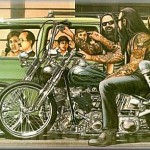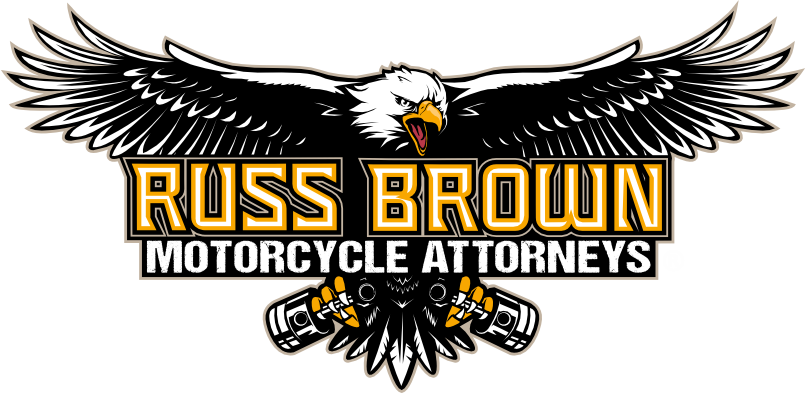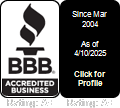
Dave Mann
It is next to impossible to talk about Easyriders Magazine, or biker art in general without including illustrator and biker artist Dave Mann in the conversation. Since 1972 Dave Mann has been directly responsible for shaping the visual world of motorcycle culture with his Rockwellesque illustrations of the motorcycle lifestyle as we know it today; breathing life into his art with the depiction of real lifestyle events and issues into every illustration that has been published in Easyriders Magazine with his surreal narratives have helped legitimize the application of artistic design in the motorcycle industry.
You could say that painting and the love of art in general was in Dave’s blood from the day he was born; Dave’s father, a lifelong commercial illustrator as well as a member of the society of scribes in London, England was said to be his initial influence. Born in Kansas City, Missouri, and as early as 1957 Dave was hard at work drawing 50’s Hot Rods and pin up girls. His early drawings earned him a job pinstriping cars at a local Kansas City custom shop.
With the allure of the West coast looming in Dave’s thoughts it wasn’t long until he couldn’t resist the wild urge any longer, setting off on the first of many road trips to come, he and a friend piled into his custom ’47 Chevy coupe and they burned rubber all the way to Santa Monica, California. While on the west coast he somehow discovered Bay Area Muffler, a local custom shop. The chopped Harley’s he saw captivated him. The expression of freedom, power and individualism blew his mind, and opened the door to a new level of artistic creativity that would rocket Dave Mann to the forefront of the motorcycle design culture with his one of a kind artistic illustrations of the Harley Davidson motorcycle and biker lifestyle that to this day have never be duplicated!
Returning home he bought his first motorcycle, a 1948 Panhead, and created his first motorcycle illustration named “Hollywood Run”. In 1963 he entered the Kansas City custom car show. With the only custom motorcycle entry in the show, the judges created a new show class to reward Dave for his efforts. A friend sent a Polaroid of “Hollywood Run” to Big Daddy Roth, the California custom auto designer and publisher of the first Chopper magazine. Blown away at the totally unique style and perspective Big Daddy Roth commissioned many posters from Dave.
Dave continued perfecting his one of a kind style and after becoming friends with David Poole he incorporated the fine art of architectural rendering into his surreal style, using the craft of detailed precision and mechanical perspective to add a new dimension into his motorcycle art. He even studied at the Kansas City Institute of art to help broaden his artistic approach. After answering an ad in Easyriders Magazine searching for a biker influenced artist, in 1972 Dave began working at Easyriders with his unique renderings of the Harley Davidson Motorcycle and bike lifestyle on the published center pages of the magazine.
Dave Mann’s art depicted the full spectrum of the biker lifestyle, including many different elements that are part of the lifestyle itself, and general topics surrounding the biker culture. Some of Dave’s creations are motif based, and an example is an illustration named “Ghost Rider” that depicts a biker riding intently down a wild west desert road with a ghost cowboy shadowing him in parallel atop his horse.
Other illustrations touched on controversial issues of the time, such as police harassment as depicted in the “Fuzz Busters” illustration that show 3 bikers being followed by police. Another similar illustration shows 2 police officers searching a biker while his girlfriend watches.
Dave’s approach was never aimed at condemnation or confrontation, but rather more of a tongue in cheek poke saying, “hey there we see ya”, or “hey brothers you know how it is!”
No matter what the topic was aimed at, every illustration Dave Mann created was focused around things that bikers understood, things that mattered to those who lived the motorcycle lifestyle, and quite often had even experienced. They were light hearted and poked fun at the biker whose bike wouldn’t start while his bros stood around laughing at him, or the frustration of the biker who ran out of gas, or got a flat tire while on a run with his bros. Other topics were more serious in nature, such as a large group run to bury a fallen brother.
While there were some renderings that touched on controversial issues within the biker community, or poked fun at the demise of common biker situations, the majority of Dave’s art work celebrated the beauty of being in the wind, or hanging out and having fun while living the biker lifestyle, and the expression of freedom that is the heart of the of the lifestyle itself. While critics were quick to say his art was sexist, demeaning to women or just plain offensive, those who cast their negative judgment on his artwork were never part of the motorcycle community, nor lived the lifestyle, and in general had no effect on his continued work, Easyriders Magazine, or the biker community.
As the year rolled on, Dave Mann’s art was richly sought after and you could see his art plastered on the walls at biker bars, custom shops, motorcycle club houses, and even in hot rod auto shops who loved the slick details of the motorcycles and the unique approach Dave Mann used to render these classic illustrations. While his illustrations were considered just as important as the custom bike spreads, tech tips and motorcycle culture articles that Easyriders Magazine published monthly, his renderings also fueled custom motorcycle builders and painters who were driven to come up with new exotic and fresh bike designs and mind blowing paint jobs. You could say that Dave’s work was a creative catalyst that helped the custom motorcycle design and building community push the envelope of custom design and paint creating new groundbreaking custom designs and styles.
There was never a single school of thought that dictated how a custom Harley motorcycle should look, and while many bikers loved full dress Harley; the Harley Davidson Chopper was by far the most popular look during the 70’s and to this day.
As his popularity continued to grow, Dave communicated his passion and love of the biker lifestyle, the freedom, and most of all the general misunderstanding that all bikers endured from those not part of the lifestyle or culture through his artwork with everyday life topics, such as Christmas, weddings, and other common life events. As the Biker lifestyle began to grow and expand during the early 1980’s, so did the motorcycle industry, and both Easyriders Magazine and Dave Mann were a dominating influence within the rapidly growing community of custom builders and painters. Each month Easyriders published new and fresh examples of the hard work and innovative designs that were being applied to custom Harley motorcycles on the pages of their magazine and as a new breed of custom builders emerged more and more people began look to at the magazine as much more than a typical biker rag.
Being a part of the motorcycle lifestyle and culture has always meant more than riding a chopper or adopting a certain attitude, and for the most part it always went hand in hand with standing up and fighting for our collective rights. With a stigma of being outlaws and drug crazed misfits looming over the motorcycle community, organizations and associations were formed to stand up and defend our rights and both Easyriders and Dave Mann were outspoken in their beliefs. One of the few illustrations Dave Mann ever created with a written message was motorcycle gas tank that had bold and vivid flames on it with the wording, “Our American rights are going up in flames.” This was the general feeling of those within the motorcycle culture, and it fueled the community to stand up and let their voices be heard. Dave’s voice was heard loud and clear through his artwork, which depicted the values and feelings held by those who lived the motorcycle lifestyle.
What was it that attracted so many to the biker lifestyle? For the most part is pure freedom and desire to be in the wind without restraint or restriction, but you can’t point to a single explanation or reason that would answer such a question but one thing is certain, those who live this lifestyle do so because they hold strong and unyielding values and anything that would try to break their spirit will only strengthen their resolve!
There have been many critics in the art world that have tried to put Dave and his biker art in a category that would help them explain his artistic motivation or gather a rational understanding of what his art is saying to the viewer. Such critics who are not part of this lifestyle couldn’t even begin to grasp the meaning or underlying message of Dave’s illustrations, so they use words like hostile, bombastic, and allegorical, instead of worlds like love, freedom, beauty, enjoyment, or individualism.
If you strip away the negative viewpoints from non motorcycle culture art critics, remove the bias of bikers by the general public, law enforcement and government what you are left with is a man who created art that was a reflection of his life, his dreams, and as he saw the world around him which strikingly parallels Vincent Van Gogh the Dutch post-Impressionist painter whose work was known for its rich color, raw beauty, bold vivid color and emotional honesty. Van Gogh’s work inspired other painters setting a new standard for other artists who worked on canvas.
Dave Mann died on September 11th 2004, and while he is physically gone, his memory, his art, and the impact he had made in the motorcycle community is still alive and very much still considered a major influence by custom Harley builders, painters, as well as other artists, tattoo artists and graphics designers world wide. Of course we can’t forget all of the bikers and motorcycle enthusiasts who found beauty, freedom and enjoyment from his illustrations, posters and paintings. Dave Mann’s impact was so great that every year in December local and national motorcycle industry get together to celebrate and pay tribute to him with the Dave Mann Chopperfest held in Ventura California.
Big Dave Hansen from In the Wind magazine said when asked why Chopperfest is so popular, “The grief felt by the entire two wheel world found expression as those who loved and respected David lined the stage with his wife to honor him just three months after his death. The love for both the “artist” and the “lifestyle” he envisioned blended perfectly through a huge showing of his original art and an equally huge showcase of custom motorcycles. Bike Builders from across the nation came to both honor David Mann at his passing and welcome the birth of his signature event. Chopperfest is forever dedicated to the design, function and art of the motorcycle through those talented enough to create and those creative enough to appreciate talent.”
It’s hard to imagine that the artwork of one man could create such a widespread impact that would reach far beyond the motorcycle culture and industry to captivate people with his vision of the Harley Davidson motorcycle, his love of the biker lifestyle and still many years after his death invoke inspiration within other artists, custom Harley builders, painters and anyone who saw his work. The physical man may be gone, but the love of his lifestyle, the Harley Davidson motorcycle and freedom he experienced while in the wind will live on forever within his artwork, paintings, his custom motorcycles and anyone who has been inspired or touched by his art, and if the words “Live to Ride, Ride to Live” are important lifestyle values to you, then a piece of Dave Mann lives within you as well!
Ride On!
Russ Brown Motorcycle Attorneys®









